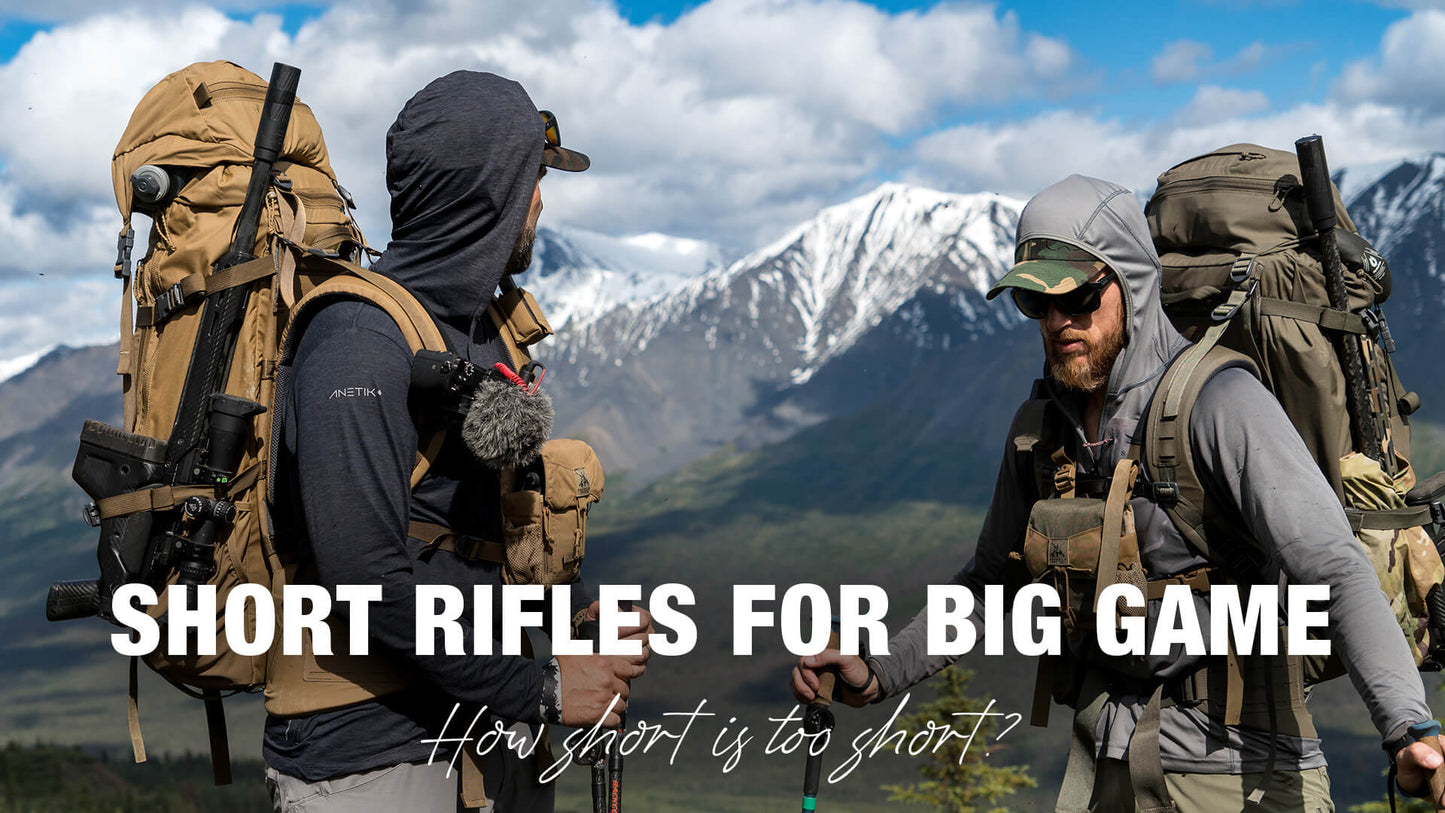
How short is too short when it comes to choosing a barrel length for hunting?
By asking this question, we are already assuming that you are interested in a shorter barrel. So we won’t spend time in this article explaining or defending the benefits of shorter barrels, nor discussing their drawbacks.
Whether you are interested in a shorter barrel for your next hunting rifle because you plan to add a suppressor, because you want to save weight, or simply because you want an easy-handling, easy-packing rifle — the fact is that short barrels are viable with today’s highly efficient bullets, laser rangefinders, and scopes that precisely and reliably dial to accommodate for drop at distance.
Over the years, my bolt-action hunting rifles have continually gotten shorter. I started at 24” (here), then went to 22” (here), then 20” (here), then 18” (here), and now I am putting together a 16.5” rifle.
Shorter, Slower, & Still Lethal
When asking “how short is too short”, what most hunters are really asking is “how slow is too slow.”
To put it another way, “How short of a barrel can I have and still effectively kill game at the distances I am willing to shoot at?”
To answer this question, we need to know several things…
- Your maximum shot distance on game
- The cartridge you will be using
- The specific bullet(s) you will be using
- The location/conditions you plan to hunt in most often
- What barrel lengths you are considering
Let’s use James as an example. He recently emailed us and asked said,
“I am building a 6mm Creedmoor, primarily for mule deer hunting in Idaho. Though I do hunt elk as well. I don’t plan to shoot past 500 yards at any game. I don’t reload yet, so I plan to use Hornady’s Precision Hunter ammunition with the ELD-X for now. I will be using a suppressor and want to minimize barrel length without sacrificing terminal performance. Would you suggest that I go with a 20”, 18”, or 16” barrel for this rifle?”
James may not have realized it, but in his email he gave us everything we need to know to answer his question on barrel length.

Mark from Exo Mtn Gear sets up for a cross-canyon rifle shot on an elk hunt, using his 18" 7SAUM rifle
Step 1 — Estimate The Speed
We know the cartridge, bullet, and ammunition James will be using. Even if he said he planned to reload, it is helpful to use factory ammunition as a starting point in calculating the estimated speed for shorter barrels.
The muzzle velocity for Hornady’s 6mm Creedmoor 103gr ELD-X Precision Hunter ammunition is listed as 3050fps with a 24” barrel (source).
A good rule of thumb with most center-fire rifle cartridges is to account for 25-35 feet-per-second of velocity lost per inch of barrel length lost. This isn’t a hard and fast rule, but it is both a reasonable expectation. And in my personal experience, it has proved to be true.
With this rule of thumb, we can use this formula…
BOX SPEED - ( (BOX BARREL - MY BARREL) * 30 )
Box speed is obviously the factory ammunition’s claimed muzzle velocity. The “box barrel” is the test barrel length for the factory ammunition. “My barrel” is the barrel length we plan to use or want to estimate speeds for. And 30 is feet-per-second we expect to lose per inch.
So if we want to estimate a velocity for James with an 18” barrel, the resulting formula would be.
That result is 2870. That is a reasonable estimate of the speeds James could expect with an 18” barrel. If he goes up to 20”, the ballpark would be 2930fps, and at the shorter 16” length the estimate would be 2810fps.
(Note — As you can see if you click on the formula above, you can enter a formula in Google directly, which will act as a calculator and provide you with the result.)
Step 2 — Know The Bullet’s Ballistics
Alright, so we have some estimated speeds at the muzzle. But to understand terminal performance downrange, we need to know two main things about the bullet — 1) The bullet’s ballistic coefficient (BC), and 2) The minimum expansion velocity of the bullet for consistent terminal performance.
BC is easy. It is a published data point. And these days, those published numbers are mostly reliable. (Let’s not venture off into the rabbit hole published but unrealistic BC numbers.)
However, understanding the “minimum expansion velocity” involves more nuance and, at times, more gray area. If you want to learn more about that, I highly suggest listening to these two podcasts — Part 1, Part 2.
Back to our example, using James’ information. The BC of the 103 ELD-X bullet is .258 (G7). And a widely used number for the minimum expansion velocity of the ELD-X bullet design is 1800fps.
(If you struggle to find reliable or consistent data on the minimum expansion velocity of the bullet you plan to hunt with, I suggest using 2000fps as the lower threshold for “cup and core” bullets, or 2200fps for all-copper bullets.)
James needs enough muzzle velocity to keep the impact velocity of his ELD-X bullet at, or above, 1800fps at his maximum range of 500 yards.
We’re almost able to answer James’ question about barrel length, but first we need to…
Step 3 — Consider The Context
Alright, we have estimated muzzle velocity (MV), the BC of the bullet, and the minimum impact velocity of the bullet. Now we need to consider the context, or the “environment” that we are planning to shoot and hunt in.

Justin from Exo Mtn Gear with a Sitka Blacktail buck he killed on a Kodiak Island ridge, just above the ocean
Depending on the ballistic calculator you use, these input variables may vary. In the case of Hornady’s app (what I use most) or their online calculator, you have the option to choose Altitude, Pressure, Temperature, and Humidity under the Environment section. Another example would be Berger’s Ballistics Calculator, which offers Temperature and Altitude as inputs for the Environment.
The biggest variable that I suggest considering for your context is altitude. When calculating for the edge of your limits (your maximum shooting distance), it is worth considering if you’ll be hunting at Sea Level, at 10,000’ on the mountain, or somewhere in between.
The Results
We have what we need to crunch some numbers in a ballistics calculator and estimate the results for James. Remember, we are using the 103gr ELD-X and factoring for James’ maximum range of 500 yards. And to illustrate the impact of altitude, we will gather speeds at sea level, at 5,000’, and at 10,000’ in elevation.
20” barrel (estimated 2930fps MV)
- 0 altitude: 2077 impact velocity
- 5k altitude: 2211 impact velocity
- 10k altitude: 2329 impact velocity
18” barrel (estimated 2870fps MV)
- 0 altitude: 2027 impact velocity
- 5k altitude: 2159 impact velocity
- 10k altitude: 2275 impact velocity
16” barrel (estimated 2810fps MV)
- 0 altitude: 1976 impact velocity
- 5k altitude: 2107 impact velocity
- 10k altitude: 2222 impact velocity
The “worst case” scenario is the shortest and slowest 16” barrel at sea level (0’ altitude), where the impact velocity of the 103gr ELD-X is still above the minimum expansion threshold at James’ max range of 500 yards.
But James’ context is mule deer (and elk) hunting in Idaho, where he is more commonly hunting at elevations around 5,000’. In that case, the shortest 16” barrel is estimated to provide an impact velocity of 2107fps.
James could reasonably choose to go with the shortest 16” barrel and still expect to have a “500-yard gun” in his hands for where he hunts.
Other Considerations
This information will enable you to calculate reasonable estimations for barrel length and terminal range, but no formula can perfectly predict actual results.
Some barrels shoot faster/slower than others. Some lots of factory ammunition vary in their speeds. If you reload, you can expect to be able to produce different muzzle velocities.
And also realize that we have only discussed muzzle velocity and impact velocity, but have not explored wind drift, trajectory curves, or other considerations.
“How short is too short?”
You make the call.
